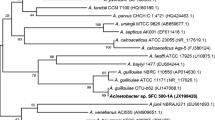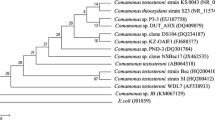Abstract
Comamonas terrigena N3H is a gram-negative rod-shaped bacterium that was isolated from contaminated soil in Slovakia. This bacterium showed remarkable biodegradation properties. We investigated the expression and functioning of two catalase isozymes in this bacterium. The typical catalase could be induced by cadmium ions, whereas the catalase-peroxidase enzyme was constitutively expressed. Since C. terrigena lacks the key enzyme for complete degradation of phenols (phenolhydroxylase), we analysed the possible removal of phenol by the two catalases of this bacterium. Addition of phenol to the culture medium led to increased expression of the catalase-peroxidase. Applying oxidative stress prior to phenol administration markedly induced the expression of the typical catalase, irrespective of the nature of the added agent. Thus, the rate of phenol degradation is rather reduced under these conditions, while growth of the cells is not impaired. We concluded that phenol peroxidation in C. terrigena can be largely attributed to the action of a catalase-peroxidase. The potential application of this enzyme in the removal of phenol from the environment is discussed.
Similar content being viewed by others
References
Al-Kassim L, Taylor KE, Bewtra JK & Biswas N (1994) Optimization of phenol removal by a fungal peroxidase from Coprinus macrorhizus in batch reactors. Enzyme Microb. Technol. 16: 120-124
Arai H, Akahira S, Ohishi T, Maeda M & Kudo T (1998) Adaptation of Comamonas testosteroni TA441 to utilize phenol: organization and regulation of the genes involved in phenol degradation. Microbiology 144: 2895-2903
Bae HS, Lee JM, Kim YB & Lee ST (1996) Biodegradation of the mixtures of 4-chlorophenol and phenol by Comamonas testosteroni CPW301. Biodegradation 7: 463-469
Bradford MM (1976) A rapid and sensitive method for the quantitation of microgram quantities of protein utilizing the principle of protein-dye binding. Anal. Biochem. 72: 248-250
Butler MJ & Lachance M (1987) The use of N.N,Nï,N-Tetramethyl-phenylenediamine to detect peroxidase activity on polyacrylamide electrophoresis gels. Anal. Biochem. 162: 443-445
Danner DJ, Brignac Jr. PJ, Arceneaux D & Vyomeschandra P (1972) The oxidation of phenol and its reaction product by horseradish peroxidase and hydrogen peroxide. Arch. Biochem. Biophys. 156: 759-763
Dunford HB & Adeniran AJ (1986) Hammett ρ σ correlation for reactions of horseradish peroxidase compound II with phenols. Arch. Bioch. Biophys. 251: 536-542
Garre V, Muller U & Tudzynski P (1998) Cloning, characterization, and targeted disruption of cpcat1, coding for an in planta secreted catalase of Claviveps purpurea. Mol. Plant-Microbe Interact. 11: 772-783
Godočíková J, Polek B, White GF, Ferianc P & Tóth D (1997) Dioctyl sulphosuccinate utilization and mineralization by bacteria Comamonas terrigena N3H. Biologia 52: 741-745
Hoshino N, Nakajima R & Yamazaki I (1987) The effect of polymerization of horseradish peroxidase on the peroxidase activity in the presence of excess H2O2: a background for a homogeneous enzyme immunoassay. J. Biochem. Tokyo 30: 674-679
Job D & Dunford HB (1976) Eur.J.Biochem. 66: 607-614
Klibanov AM, Alberti BN, Morris ED & Felshin LM (1980) Enzymatic removal of toxic phenols and anilines from waste waters. J. Appl. Biochem. 2: 414-420
Klibanov AM & Morris ED (1981) Horseradish peroxidase for the removal of carcinogenic aromatic amines from water. Enzyme Microb. Technol. 3: 119-122
Owen RT & White GF (1989) Metabolic pathway for the biodegradation of sodium dodecyl sulfate by Pseudomonas sp. C12B. Biotechnol. Appl. Biochem. 11: 318-327.
Peter MG & Wollenberger U (1997) Phenol-oxidizing enzymes: mechanisms and applications in biosensors. EXS 80: 63-82
Quick A, Russell NJ, Hales SG & White GF (1994) Biodegradation of sulphosuccinate: direct desulphonation of a secondary sulphonate. Microbiol. 140: 2991-2998.
Roggenkamp R, Sahm H & Wagner F (1974) Microbial assimilation of methanol induction and function of catalase in Candida boidinii. FEBS Lett. 41: 283-286
Stohs SJ & Bagchi D (1995) Oxidative mechanisms in the toxicity of metal ions. Free Radic. Biol. Med. 18: 321-336
Towbin H, Staehelin T & Gordon J (1979) Electrophoretic transfer of proteins from polyacrylamide gels to nitrocellulose sheets: procedure and some applications. Proc. Natl. Acad. Sci. USA 76: 4350-4354
Welinder KG (1992) Superfamily of plant, fungal and bacterial peroxidases. Curr. Opin. Struct. Biol. 2: 388-393
Woodbury WA, Spencer K & Stahlmann MA (1971) An improved procedure using ferricyanide for detecting catalase isozymes. Anal. Biochem. 44: 301-305
Wu Y, Taylor KE, Biswas N & Bewtra JK (1998) A model for the protective effect of additives on the activity of horseradish peroxidase in the removal of phenol. Enzyme Microb. Technol. 22: 315-322
Yang RD & Humphrey AE (1975) Dynamic and steady state studies of phenol degradation in pure and mixed cultures. Biotechnol. Bioeng. 17: 1211-1235
Zámocký M & Koller F (1999) Understanding the structure and function of catalases-clues from molecular evolution and in vitro mutagenesis. Prog. Bioph. & Mol. Biology 72: 19-65
Zámocký M, Godočíková J, Polek B & Koller F (1998) Molecular evolutionary trends and in vitro engineered mutants-clues to understand the structure-function relationships in catalases. Chemical papers 52: 333
Author information
Authors and Affiliations
Corresponding author
Rights and permissions
About this article
Cite this article
Zámocký, M., Godočíková, J., Koller, F. et al. Potential application of catalase-peroxidase from Comamonas terrigena N3H in the biodegradation of phenolic compounds. Antonie Van Leeuwenhoek 79, 109–117 (2001). https://doi.org/10.1023/A:1010294130534
Issue Date:
DOI: https://doi.org/10.1023/A:1010294130534




